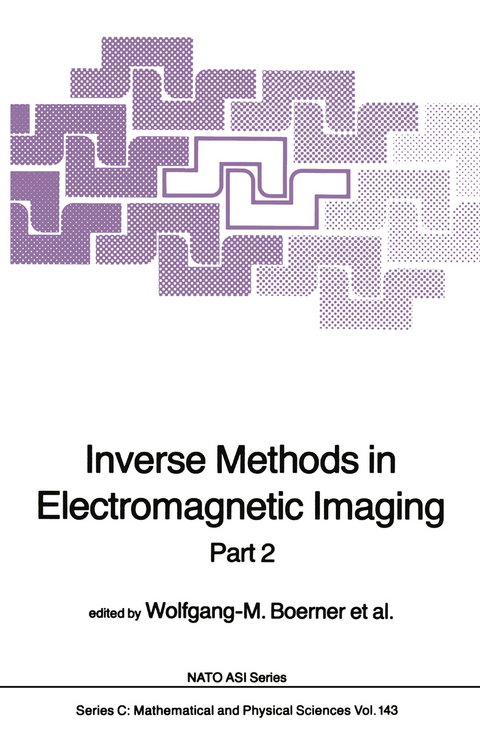
Inverse Methods in Electromagnetic Imaging
Springer (Verlag)
978-94-010-8828-2 (ISBN)
Table of Contents (Part 2).- TOPIC III (Papers are cross-referenced with the Final Technical Program (Outline. Given are session and sequence of presentation, i.e., OS.3).- III.10 (SR.4) Study of Two Scatterer Interference with a Polarimetric FM/CW Radar.- III.11 (SP.5) Polarization Dependence in Angle Tracking Systems.- III.12 (SS.4) Interpretation of High Resolution Polarimetric Radar Target Down-Range Signatures Using Kennaugh’s and Huynen’s Target Characteristic Operator Theories.- III.13 (MM.5) Demands on Polarization Purity in the Measurement and Imaging of Distributed Clutter.- III.14 (SP.2) Polarization Vector Signal Processing for Radar Clutter Suppression.- Topic IV — Image Quality and Image Resolution in Remote Sensing and Surveillance.- IV.1 (RS.1) The Radiative Transfer Approach in Electromagnetic Imaging.- IV.2 (RP.4) Towards a Theory of Perception for Radar Targets with Application to the Analysis of Their Data Base Structures and Presentations.- IV.3 (SI.4) Radar Imagery.- IV.4 (SI.1) Inverse Methods Applied to Microwave Target Imaging.- IV.5 (SR.1) (SP.4) Optimum Detection Techniques in Relation to Shape and Size of Objects, Motion Pattern and Material Composition.- IV.6 (RS.3) Inverse Methods for Ocean Wave Imaging By Sar.- IV.7 (RS.2) Inverse Methods in Rough-Surface Scattering.- IV.8 (SI.2) On the Optimum Detection of Surface Chemical Compounds.- IV.9 (SI.3) Inversion Problems in Sar Imaging.- IV.10 (SI.5) Inverse Methods in Radio Glaciology.- IV.11 (MI.1) Fast Millimeter Wave Imaging.- IV.12 (IM.2) Electromagnetic Low Frequency Imaging.- IV.13 (MI.5) Electromagnetic Imaging of Dielectric Targets.- IV.14 (MI.3) A Four-Channel Millimeter-Wave On-Line Imaging Method.- TOPIC V — Holographic and Tomographic Imaging and Related Phase Problems.-V.1 (0I.1) The Holographic Principle.- V.2 (PT.1) Review of Tomographic Imaging Methods Applied to Medical Imaging.- V.3 (MM.1) Inverse Methods in Microwave Metrology.- V.4 (MI.2) Holographic & Tomographic Imaging with Microwaves and Ultrasound.- V.5 (PT.4) Diffraction Tomography.- V.6 (PT.3) Algorithms and Error Analysis for Diffraction Tomo-Graphy Using the Born and Rytov Approximations.- V.7 (PT.5) Extension of Scalar to Vector Propagation Tomography — A Computer Numerical Approach.- V.8 (OI.4) Image Processing: Analysis Beyond Matched Filtering.- V.9 (OI.3) Modifications of the Gerchberg Method Applied to Electromagnetic Imaging.- V.10 (MI.4) Phase Comparison Monopulse Side Scan Radar.- V.11 (MM.4) Diagnostic Measurements and Analysis of Wave Mechanisms in Radomes.- V.12 (OI.2) Synthesis & Detection of Electromagnetic Authenticity Features.- V.13 (SR.5) Improvement of Image Fidelity in Microwave Imaging Through Diversity Techniques.- V.14 (SP.6*) Far-Field to Near-Field Transforms in Spherical Coordinates.- TOPIC VI — Working Discussion Group Reports.- VI Final Reports of Working Discussion Groups Background.- VI.1 Mathematical Inversion Methods and Transient Techniques (W-A).- VI.2 Numerical Instabilities in Electromagnetic Inverse Problems (W-B).- VI.3 Polarization Utilization in High Resolution Imaging (W-C).- VI.4 Definition of Image Quality and Image Resolution in Remote Sensing and Surveillance (W-D).- VI.5 Holographic and Tomographic Imaging and Related Phase Problems (W-E).- VI.6 Enhancement of Interaction Between Active R&DLabs within Nato-Member Countries on the Subject of Electromagnetic Imaging (W-F).- VI.7 Overall Final Report.- Final Technical Program Outline.- Keyword Index.- Author Index.- List of Invitees.
| Reihe/Serie | NATO Science Series C ; 143 |
|---|---|
| Zusatzinfo | 3 Illustrations, color; 167 Illustrations, black and white; XII, 1347 p. 170 illus., 3 illus. in color. |
| Verlagsort | Dordrecht |
| Sprache | englisch |
| Maße | 155 x 235 mm |
| Themenwelt | Schulbuch / Wörterbuch |
| Geisteswissenschaften | |
| Naturwissenschaften ► Physik / Astronomie ► Elektrodynamik | |
| Sozialwissenschaften | |
| Technik | |
| ISBN-10 | 94-010-8828-4 / 9401088284 |
| ISBN-13 | 978-94-010-8828-2 / 9789401088282 |
| Zustand | Neuware |
| Haben Sie eine Frage zum Produkt? |
aus dem Bereich


